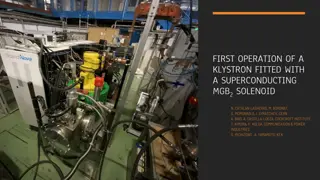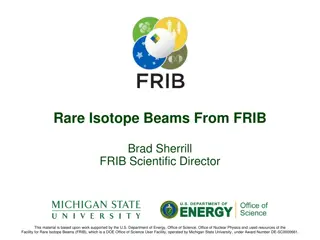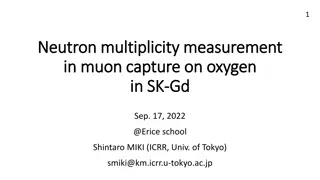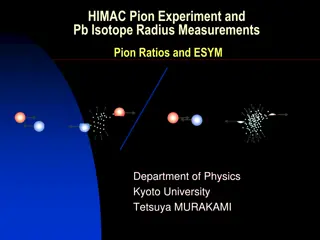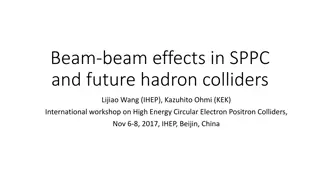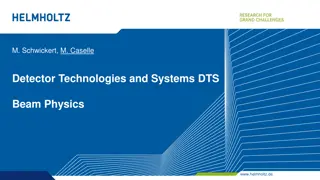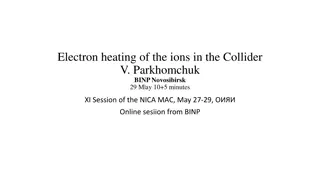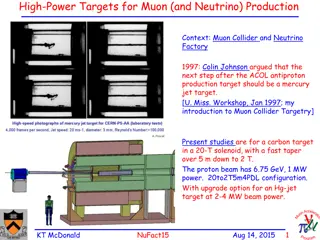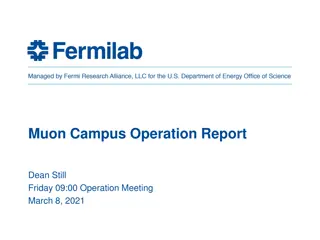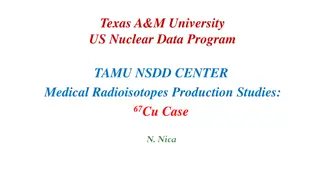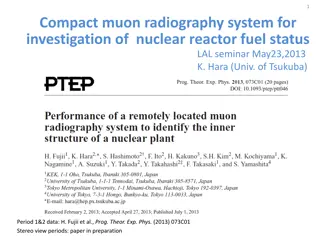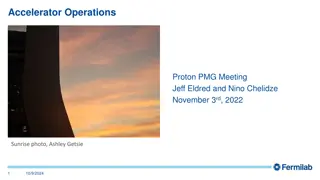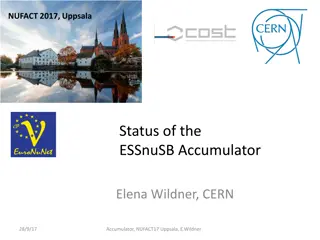Isotope Production Technique by Muon Beam from Pion Capture Solenoid System
Isotope production technique using muon beam from pion capture solenoid system at JPARC, focusing on data analysis of targets like 93Nb, 100Mo, and 181Ta over three experimental days. Explore the relevance of energy peaks to potential isotopes, with reference to nuclear data sheets for Ta-181 decay. Dive into the challenges of data analysis in nuclear physics.
Download Presentation

Please find below an Image/Link to download the presentation.
The content on the website is provided AS IS for your information and personal use only. It may not be sold, licensed, or shared on other websites without obtaining consent from the author.If you encounter any issues during the download, it is possible that the publisher has removed the file from their server.
You are allowed to download the files provided on this website for personal or commercial use, subject to the condition that they are used lawfully. All files are the property of their respective owners.
The content on the website is provided AS IS for your information and personal use only. It may not be sold, licensed, or shared on other websites without obtaining consent from the author.
E N D
Presentation Transcript
Isotope Production Technique by Muon Beam from Pion Capture Solenoid System using Root v5 Dedicated to Dr. Izyan Hazwani + JPARC (Prof. Ejiri)
Data Files available from JPARC (Japan Proton Accelerator Research Centre) According to Dr. Izyan s slides, MUSE beamline, MLF was used with intensity = 105 -/s and 30 MeV/c of muon momentum. The targets are 93Nb, 100Mo, and 181Ta. Experiments done on three consecutive days (from 2014-06-18 to 6-20) A total of 17 data files were generated on the first day, 12 on the second while 15 on the third, summing up to total of 34 data files for three days. However, only four were chosen for further analysis. For the early data files, because the activity of the sample is still quite high, so we require only short measurement time to obtain the intensity. However, as time passes the activity of the sample recedes due to decay. Thus we will need longer measurement time (i.e.: 24 hours or equivalent to 86400 sec) to gain enough statistical data for each peaks. Naming of the data files, i.e.: GMX4_20140620_123852.
Data Analysis requires nuclear physics knowledge Due to decaying of Tantalum-181 (target of experiment), any related isotopes with the half life between 30 minutes to 3 days are considered relevant. Measurement of very short-lived nuclei is practically impossible while for too long-lived is impractical. Thus, aside from technical analysis of those data files using Root v5, we ventured out to find out more about those energy peaks could represent about~! (possibly another isotope that Ta-181 decayed to) At initial stage, TWO nuclear datasheets were referred to
Nuclear Data Sheets for A = 180 Nuclear Data Sheets 126 (2015) 151-372 @ ScienceDirect by E.A. Mccutchan Nuclear Data Sheets for A = 182 Nuclear Data Sheets 130 (2015) 21-126 @ ScienceDirect by Balraj Singh
Continue Unfortunately, the nuclear data from the nuclear data sheets was not ample enough for our data analysis due to missing of low intensity peaks. So, Dr. Izyan introduced another source, a link provided by JAEA (Japan Atomic Energy Agency): http://wwwndc.jaea.go.jp/NuC/sbygame.html
Nuclide 72-Hf-180 72-Hf-180 332.27 72-Hf-180 443.16 Energy(keV) Intensity(%) Decay mode 215.43 81.32 94.12 81.88 Half life 5.5H 5.5H 5.5H Effective Intensity(dps) 2.85E-05 3.29E-05 2.87E-05 IT IT IT 181Ta ( , n) 180Hf
Technical Work (Result is the main priority!!) From technical problems faced during installation of Ubuntu, root, and even trying to use UNIX system on Windows (Cygwin), etc. In the end, I realized, stop wasting time on those unnecessary stuff Basically, there are FOUR main steps I need to follow. 1st: Read, check carefully each data files, and change the first row count from (usually 0) to real time measurement. Also, convert them into text files using Excel
Continue 2nd: By studying Mo1_140keV.C, make similar coding for Ta1, Ta2, Ta3, and Ta4 (four selected data files). Change only the range and value of energy and counts area (SetParLimit and FixParLimit). Make two or more Gaussian peaks depending on graphs analysed. Some simple commands needed: $ root l [open root] $ .L Ta1_215keV.C $ Ta1( GMX4_20140618_100940.txt )
Continue 3rd: Several further analysis that need to be revised: checking the Full Width Half Maximum (FWHM) of all peaks. Make sure all sigma(s) (statistical errors) fit in the line so that Chi square is less than or close to 1.
To Be Continued 4th: Muon activation analysis is on green light then! Estimate the initial activity of the isotope and the reaction rates of the decay. By referring to the equations in MCID paper, Y(X ), N(X ) and R(X ) can be calculated. To obtain N0(X ), the decay curve need to be plotted using F1_98Nb_722keV.C (for single decay mode) F1_98Nb_140keV.C (for multiple decay mode, transient radioactive equilibrium) Plot R(X ) for all capture products in one figure.
THANK YOU FOR LENDING ALL EARS~ HOPE TO SEE YOU AGAIN NEXT TIME ~ENJOY YOUR DAY~



